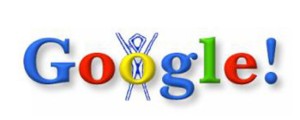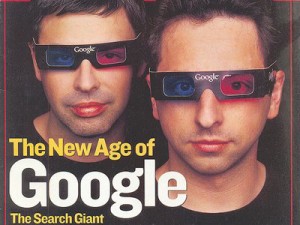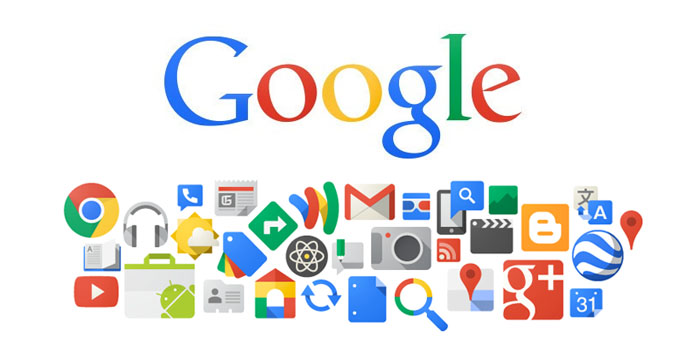The History of Google

Google’s first logo and doodle, featuring the Burning Man, in 1998.
(http://www.cnet.com/pictures/our-favorite-google-doodles-through-the-years-pictures/)
Google has a lot of nifty tricks hidden within the search engine, and among the multitude of keywords that curious netizens have discovered is google in 1998. Typing the words in Google’s search box leads to a version of Google when it was first released to the world on September 27, 1998. It was a much simpler time, when most search engines were looking for quantity instead of quality, Facebook was nowhere in sight, and Windows 98 was still a thing. Although it still has the same blue-red-yellow-green color scheme, the Google of today is vastly different from Google in the late 90’s; it has a résumé now covering nearly every part of the technology spectrum.
How did a simple search engine turn into one of the greatest legacies of all time? It all started with two not-so-best friends.

The brains of the evolution: Larry Page and Sergey Brin.
(http://www.businessinsider.com/history-sergey-brin-larry-page-and-google-strategy-2011-3)
While a lot of success stories involving computers star a college dropout (who actually has enough money to be able to afford not to go to college), Google came around because of academics. Stanford University student Lawrence “Larry” Page proposed it as his doctoral dissertation, and he would later be joined by fellow computer science student, Sergey Brin. Their published research paper was entitled The Anatomy of a Large-Scale Hypertextual Web Search Engine. Together, they coded the components of what would be later known as Google Search. However, the two weren’t exactly Damon and Pythias. At first, they were more like Zeus and Poseidon. (If you didn’t get the reference, try Googling it.)
When the geek gods first met, they weren’t exactly the great tag team duo known today. In fact, they really disliked each other. University of Michigan undergraduate Larry Page went on a campus tour around Stanford, and by a twist of fate, he was placed in the company of a certain Sergey Brin. Legend has it that the two students bickered throughout the tour, with one side thinking that the other was obnoxious, and they often disagreed on many things. Despite their contrasting qualities, they managed to avoid a full-scale nerd war. When Page decided to start his research project, it was Brin who came to help. Their relationship was like the magnets we learn from physics class—two opposite charges dragging each other closer and closer.
Page first created a web crawler that could collect backlinks. From there, he began his research project, which he called BackRub. When Page conceived BackRub, there were around 10 million documents in the Web, all with a sheer number of links connecting them. Before, search engines used the number of visits per page to rank their links. Page instead went the opposite direction and planned out a way so that a link would be ranked according to how many pages link back to it. At this point, Brin became interested in the project’s daunting scope and complexity, and joined Page in his work.
This endeavor was greatly influenced by bibliometrics, the study of citations. Links, according to Page, work like citations in a paper; one of the key factors in determining the authenticity and importance of a paper is the number of citations it has to other papers and the number of papers citing it back. Using this idea as a foundation, Page and Brin devised an algorithm that could quantify every single backlink that their web crawler collected, and later refined it so that links could be ranked according to their importance. This algorithm, named PageRank, was integrated into BackRub. The web crawler was launched at their homepage in Stanford’s website, with the domain name google.stanford.edu, and their first search engine prototype was born.
After the massive success of their search engine (i.e. reaching 10,000 queries a day), the duo decided to create a company based around it. A legacy was born when they registered the domain name google.com on September 17, 1997. The company itself, Google, was formally incorporated on September 4, 1998. (Fun fact: One of the world’s most well-known names is a typo. It was originally going to be googol.com.) As the company was short on funds, Page and Brin set up their business in Page’s dorm, and their server consisted of ten 40GB hard disks stored inside a rack made of LEGO. They later recruited fellow Stanfordite, Craig Silverstein, as their first employee.
On August 30, 1998, Google released their first ever doodle, which contained the logo (which still has an “!”) and a stick figure of the Burning Man of Burning Man Festival fame. It was actually an out-of-office notice as Page and Brin went to the eponymous festival. By December 1998, Google was named PC Magazine’s search engine of choice in their Top 100 Web Sites, reaching 500,000 queries a day and surpassing its fellow search engines at the time.
They moved to a new location at Palo Alto on February 1999, with just eight employees in tow, and later to their first Mountain View office in August. From there, Google Inc. developed programs that complemented the search engine. Many of these can still be seen today (and start with the word Google), such as Google AdWords, a self-service ad program, Google Toolbar, Google Images, Google Print (now Google Books), Google News, and Orkut, a popular social network in its heyday. They acquired several companies, including Pyra Labs, who created Blogger, and Keyhole, whose technology would be instrumental in creating Google Earth. Websites were also acquired by Google; one such website was Deja.com’s Usenet Discussion Service, which would later be launched as Google Groups.In 2001, software engineer Eric Schmidt was named chairman of the board and later became CEO of Google Inc. for ten years.
In March 2004, Google’s workforce numbered up to over 800 employees. Needing a larger area to accommodate its growing population, the company decided to move to its present location in Mountain View, California. The new office complex, “Googleplex,” became well known for its various entertainment devices such as slides and bikes. Even more Google apps were launched, most importantly Gmail, Google Translate, and Google Maps, all of which are popular among students and tourists alike. In 2006, they acquired YouTube.
In 2007, Google ventured beyond tech space and into the physical realm as they launched google.org, Google’s charitable arm dedicated to using technology to help others. They also acquired several word processing and spreadsheet software that were compiled and released as Google Docs. Later that year, Google launched the tech world’s most beloved green robot: Android! Aside from its new OS, Google also launched its own browser, Google Chrome, a cloud storage device, Google Drive, and a virtual reality device, Google Cardboard.

Since its creation in 1998, Google has expanded its network to nearly every aspect of technology.
(http://awesomelytechie.com/google-plus-phased-out-bloggers/)
From a simple search engine, Google has expanded into each and every aspect of technology, integrating itself into modern life. Even now, it continues to venture out to greater horizons, innovating and re-innovating products and apps for the world to use. As said by the main man Larry Page himself, “I don’t think we’re going to run out of important things to do, compared with the resources that we have. There are many, many problems in the world that need solving.”
With limitless possibilities for innovation (and the apparent goal of saving the world), what does Google have in store for us next?
Sources:
Our history in depth: (https://www.google.com.ph/about/company/history/) [14 October 2015]
Shontell, Alyson: 13 Unusual Ways Sergey Brin And Larry Page Made Google The Company To Beat: (http://www.businessinsider.com/history-sergey-brin-larry-page-and-google-strategy-2011-3) [14 October 2015]
The Anatomy of a Search Engine: (http://infolab.stanford.edu/~backrub/google.html) [15 October 2015]

Comments